Adrian J Cotterill, Editor-in-Chief
It has been a tradition for the last five years that we always post our look back on some of the best that the year had to offer sometime between Christmas and the New Year.
Online at least, this year is no different (you are reading this post now online for the first time one assumes) but if you picked up one of the 11,000 copies of our book DOOH Insights Volume 2 then you will already have read this in print.
This list, in no particular order, was compiled along with all of our contributors and like all ‘best of’ rankings, it is in no way scientific.
Enjoy …
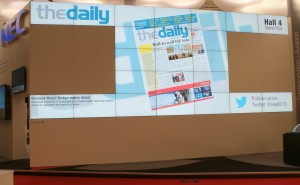 First shown by NEC Display Solutions in January 2013 at ISE in Amsterdam Die Pixel-Maschine was an innovative 23 panel, seven tiles wide by five tiles high, video wall in perhaps one of the best configurations ever shown at a trade show. The shape however was specifically designed to accommodate the content needs and requirements of multiple pieces of information required on a busy show floor. The two panel tile extensions on both sides, top and bottom of the display (known as ‘Fingers’) and the ‘Main Wall’ of the display, made up of 15 panels in the centre are there for a reason. A Finger is typically home to key specific elements of secondary informative content whilst the main wall is usually used for the really important ‘hero’ content that needs to be conveyed to passers-by and those people on the stand itself. Whilst each individual panel had the capability of displaying a native resolution of 1920 x 1080 Die Pixel-Maschine ran a massive 13,500 x 5,440 resolution by ‘stitching’ all of the panels together into a single canvas using a combination of Hiperwall and Scala software. That resolution is half as much again as the highest prototype displays being developed (8k) and just over three times that of the largest digital cinema format in common production (4k). Die Pixel-Maschine and the content that ran on it was recognised by the public and the press alike – even making the front cover of the ISE Daily trade newspaper on the final day of the show.
First shown by NEC Display Solutions in January 2013 at ISE in Amsterdam Die Pixel-Maschine was an innovative 23 panel, seven tiles wide by five tiles high, video wall in perhaps one of the best configurations ever shown at a trade show. The shape however was specifically designed to accommodate the content needs and requirements of multiple pieces of information required on a busy show floor. The two panel tile extensions on both sides, top and bottom of the display (known as ‘Fingers’) and the ‘Main Wall’ of the display, made up of 15 panels in the centre are there for a reason. A Finger is typically home to key specific elements of secondary informative content whilst the main wall is usually used for the really important ‘hero’ content that needs to be conveyed to passers-by and those people on the stand itself. Whilst each individual panel had the capability of displaying a native resolution of 1920 x 1080 Die Pixel-Maschine ran a massive 13,500 x 5,440 resolution by ‘stitching’ all of the panels together into a single canvas using a combination of Hiperwall and Scala software. That resolution is half as much again as the highest prototype displays being developed (8k) and just over three times that of the largest digital cinema format in common production (4k). Die Pixel-Maschine and the content that ran on it was recognised by the public and the press alike – even making the front cover of the ISE Daily trade newspaper on the final day of the show.- #2013SignExpo Digital Signage Zone. We actually don’t have enough high quality events in our industry. Yes, we have the same old AV get togethers but seriously (with the exception of Digital Signage Expo), where are the conferences and exhibitions focused on digital signage and digital out of home and where are the events people can go to, in order to get more business and meet new people? Well, in 2013 we had the start of a new one, something that we think will get quite quickly get bigger and better. We are talking of course of the International Sign Association’s International Sign Expo 2013 and in particular their Digital Signage Zone/Dynamic Digital Park in Las Vegas April 3-6 at the Mandalay Bay Convention Center. The International Sign Expo is of course the place to be for the sign industry and we believe that it’s about to become a very important place for our industry to be as well. In 2014, the International Sign Association‘s International Sign Expo aka #2014SignExpo will be held 24-26 April 2014 (preceded by an education day) in Orlando, Florida.
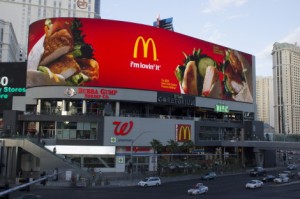 It’s not just the size of Harmon Corner that makes it stand out, it’s the quality of the images shown on this LED. Billed as the World’s Largest Full Motion LED and located in the middle of the Las Vegas Strip, the Harmon Corner Digital Screen is truly an iconic American landmark and we think, rivals for impact many of the screens found in Times Square. At 60’ x 306’ (or 18,360 sq. ft.) it is longer than the length of a US football field and the size of 27 typical roadside billboards. Not surprisingly, during 2013 it has run some superb campaigns and is always seemingly full of great content – BroadSign X digital signage software is used for daily playback and coolux Pandoras Box for various live performances and events. The LED is a 12mm pixel pitch product from YESCO and the control system (built by Brian Henry whilst he was at YESCO but now out on his own) is composed of 12 discreet 1280×720 displays all powered by a a single Dell R5500 rack workstation and hot spare backup. The resolution is 7360×1440 pixels and there is no scaling as the content is played back at 1 x 1. Harmon Corner is one of the many iconic digital spectaculars across North America owned and operated by Branded Cities.
It’s not just the size of Harmon Corner that makes it stand out, it’s the quality of the images shown on this LED. Billed as the World’s Largest Full Motion LED and located in the middle of the Las Vegas Strip, the Harmon Corner Digital Screen is truly an iconic American landmark and we think, rivals for impact many of the screens found in Times Square. At 60’ x 306’ (or 18,360 sq. ft.) it is longer than the length of a US football field and the size of 27 typical roadside billboards. Not surprisingly, during 2013 it has run some superb campaigns and is always seemingly full of great content – BroadSign X digital signage software is used for daily playback and coolux Pandoras Box for various live performances and events. The LED is a 12mm pixel pitch product from YESCO and the control system (built by Brian Henry whilst he was at YESCO but now out on his own) is composed of 12 discreet 1280×720 displays all powered by a a single Dell R5500 rack workstation and hot spare backup. The resolution is 7360×1440 pixels and there is no scaling as the content is played back at 1 x 1. Harmon Corner is one of the many iconic digital spectaculars across North America owned and operated by Branded Cities.- In May 2013, Ayuda Media Systems unveiled the Cerebro planning optimization engine. Cerebro is not just a clever piece of software, it’s a piece of software that just might point the way that software services are written and deployed in the future. Cerebro is a revolutionary media planning and optimization tool specifically designed for Outdoor operators to maximize occupancy rates, during the planning, proposal, and booking phases of the media sales workflow – it’s a mathematical optimization engine that takes prioritized goal inputs such as reach, frequency, Target Rating Points, panel amount goals, and geographical location goals and delivers a plan that optimizes over those targets – it also uses various mathematical optimization and meta heuristic techniques to combine these disparate goals and output an optimal plan. Because the Cerebro planning optimization engine is exposed as a web service, it can plug into any contemporary sales, proposal, or charting tool that is typically used today by the Outdoor operator, including homegrown software (of course it also seamlessly integrates with the Ayuda Platform, for those operators already using Ayuda). So why wouldn’t outdoor people just use the existing TAB web services to obtain TRPs and Reach and Frequency data? Well, that’s fine, until you want to add geographical constraints or optimize over specific geographic coverage, in which case the mathematics quickly become non-linear and complex. You can use TAB web services to create a 200 TRP plan in a specific DMA, but what if you want those 200 TRPs to come from specific targeted locations? That’s quite difficult, which is why you need the brain of a media planner. Cerebro is THAT brain, the brain that automates this process, no matter how many plan objectives you throw at it – basically returning a media plan that optimizes over all of the potentially unlimited objectives you feed it. This non-linear optimization is the core of Cerebro’s power, and the math behind it is what Ayuda does so incredibly well. By making Cerebro available as a set of web services separate from Ayuda’s core platform, they have helped the entire industry maximize their occupancy rates while leveraging TAB OOH ratings (which of course are all proposed from their own available inventory). In June, 2013, Ayuda also announced the simplification of consumption of Route data allowing UK Outdoor operators who wish to license and use the Route data to enhance their media plans, proposals, and campaign scheduling as well.
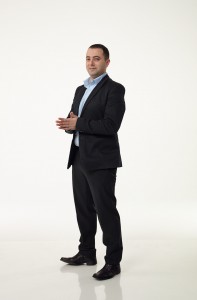 Stephen Borg. There is only one person we can think of who talks any sense about digital signage and retail. Seriously, just one person and that is Stephen Borg, Director, Global Strategy and Market Development with the AOPEN Group. You may have had the privilege of hearing him speak, most probably with a Red Design Group hat on (he is also an advisory board member of the Red Design Group and related companies). Stephen spends even more time globe-trotting than we do and we have bumped into each other on the ‘speaking circuit’ in a few odd places. Taiwan is perhaps not that odd for him, what with AOpen’s owners, manufacturing and head office all being there but it was in front of almost 300 people at the Taiwanese Digital Signage Multimedia Association’s (DSMA) annual forum during COMPUTEX TAIPEI that we heard, even for Stephen, one of his best presentations ever. Stephen fittingly finished up the event, the DSMA had saved the most dynamic and thought provoking presentation to last and he spoke of ‘Design and Digital – reinventing the total customer experience‘. His knowledge of the retail sector and what makes it work is second to none – couple that with his Fujitsu Retail, Fujitsu TELentice digital signage background and AOpen have with him a great force to get retailers to add digital into their mix – Stephen would be the first to say “where appropriate”. That ‘appropriateness’ was very much the point of most of his presentation – he showed designs and real world examples with and without digital signage. He took the the audience through the process of why he chose such and such for each retailer (their brand, their needs, their budget, etc.) and for the first time ever, we had someone from AOpen manage to clearly explain the AOpen OpenService offering (something that no-one else has ever managed to do).
Stephen Borg. There is only one person we can think of who talks any sense about digital signage and retail. Seriously, just one person and that is Stephen Borg, Director, Global Strategy and Market Development with the AOPEN Group. You may have had the privilege of hearing him speak, most probably with a Red Design Group hat on (he is also an advisory board member of the Red Design Group and related companies). Stephen spends even more time globe-trotting than we do and we have bumped into each other on the ‘speaking circuit’ in a few odd places. Taiwan is perhaps not that odd for him, what with AOpen’s owners, manufacturing and head office all being there but it was in front of almost 300 people at the Taiwanese Digital Signage Multimedia Association’s (DSMA) annual forum during COMPUTEX TAIPEI that we heard, even for Stephen, one of his best presentations ever. Stephen fittingly finished up the event, the DSMA had saved the most dynamic and thought provoking presentation to last and he spoke of ‘Design and Digital – reinventing the total customer experience‘. His knowledge of the retail sector and what makes it work is second to none – couple that with his Fujitsu Retail, Fujitsu TELentice digital signage background and AOpen have with him a great force to get retailers to add digital into their mix – Stephen would be the first to say “where appropriate”. That ‘appropriateness’ was very much the point of most of his presentation – he showed designs and real world examples with and without digital signage. He took the the audience through the process of why he chose such and such for each retailer (their brand, their needs, their budget, etc.) and for the first time ever, we had someone from AOpen manage to clearly explain the AOpen OpenService offering (something that no-one else has ever managed to do).- Barry Frey joins the DPAA. Barry was most definitely not the first choice President and CEO but he may well end up being the best choice ever. In May 2013, after what seemed like a long and interminable search, the Digital Place-based Advertising Association announced that Barry Frey had been hired as the organization’s new president and chief executive officer to replace previous incumbent Susan Danaher, who resigned from the DPAA to accept a position at Adspace Digital Mall Network earlier in the year. Barry Frey is a long-time media and marketing visionary with extensive leadership credibility in building interactive, television and other and cross-platform media businesses for marketers. Some of his greatest triumphs throughout his career have been bringing important innovative products and initiatives to the advertising community and he is therefore a perfect fit to help the industry get to grips in this new era of video agnostic planning and buying. Barry sees digital place-based screens and networks as powerful solutions for advertisers seeking to engage today’s on-the-go consumers. Barry was most recently a senior advisor at Sonenshine Partners, a New York-based investment bank that provides integrated strategic and financial advisory services and he worked with clients in the television, digital and advertising categories, helping them develop successful growth strategies in a rapidly changing business landscape. Before joining Sonenshine, Barry spent more than seven years as architect, marketer and chief revenue officer for Cablevision’s digital and advanced advertising business. As executive vice-president, advanced platform sales, he oversaw the company’s digital transformation of advertising sales and led the creation of new revenue streams by building what was widely credited as the leading advanced TV ad business in the U.S. You can tell that Barry has a global picture of and solid background in the media world and has a tremendously good perspective of where technology has been able to take media products and then where media helps with advertising, and with advertiser and agency needs. Barry knows that this industry has huge potential and that DPPA members, and potential members, can help build a big pie together, which is ultimately what he is starting to do.
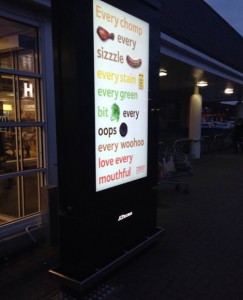 JCDecaux’s UK TESCO deployment. JCDecaux UK’s new TESCO deployment is transforming the traditional OOH sales model into an objective and audience led dynamic. This enterprise class initiative utilises the comprehensive data available from the Route OOH audience analytics combined with Tesco retail and loyalty card transactions, which should deliver new levels of audience targeting and performance accountability. It is also JCDecaux UK’s first ever 100% digital screen network. Whilst many believe that the earlier debacle that was Tesco TV (latterly called Tesco Screens and finally shut down back in early 2009) set the UK and continental European retail digital signage market back several years, this new initiative is all set to show the industry how it should be done. Whilst many industry observers were waiting for JCDecaux to launch the Waterloo Motion (not now scheduled for launch until early 2014), it was the 400 digital screens being erected outside UK Tesco stores that was their really big digital initiative. Fusing data from the UK outdoor industry’s Route research, with Tesco’s Dunnhumby retail sales data may just change the way digital signage at retail is viewed going forward.
JCDecaux’s UK TESCO deployment. JCDecaux UK’s new TESCO deployment is transforming the traditional OOH sales model into an objective and audience led dynamic. This enterprise class initiative utilises the comprehensive data available from the Route OOH audience analytics combined with Tesco retail and loyalty card transactions, which should deliver new levels of audience targeting and performance accountability. It is also JCDecaux UK’s first ever 100% digital screen network. Whilst many believe that the earlier debacle that was Tesco TV (latterly called Tesco Screens and finally shut down back in early 2009) set the UK and continental European retail digital signage market back several years, this new initiative is all set to show the industry how it should be done. Whilst many industry observers were waiting for JCDecaux to launch the Waterloo Motion (not now scheduled for launch until early 2014), it was the 400 digital screens being erected outside UK Tesco stores that was their really big digital initiative. Fusing data from the UK outdoor industry’s Route research, with Tesco’s Dunnhumby retail sales data may just change the way digital signage at retail is viewed going forward.- NanoLumens install Penn Station. Hot on the heels of a NanoLumens announcement of several large NanoSlim displays being used to provide vivid, long-life video solutions for the new Sao Paulo Metro Line 4 in Brazil came this install in New York City’s Penn Station. One of the best large indoor display installations we have seen this year. Capitalising on the massive daily audience that passes through the station, CBS Outdoor turned to NanoLumens to provide a unique solution that simply can’t be missed. It’s actually a 4.5-inch thick, double-sided 126” NanoSlim LED display using NanoLumens’ 4mm pixel pitch technology and hangs directly over commuters heads as they travel through the Long Island Railroad corridor of the station. It’s also the first time that a digital advertising display has ever been suspended from the ceiling in Penn Station – something which is possible because the whole display weighs less than 700 pounds (and uses less than one-third of the energy that a comparable LCD, plasma or projection setup would require). The NanoSlim has a lifespan of 100,000 hours so should still be running in 11 years time, even if it was running 24 hours a day. To us, this looks like one most potent messaging platforms in Penn Station.
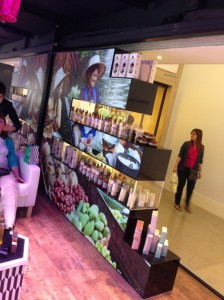 Thailand Tourism Harrods Window Display. Harrods, the masters of Retail Theatre are no strangers to plaudits from us (and from many others) and in 2013 it was a temporary window display, put together by Cardiff, UK-based exhibition and display technology company Alchemy and Harrods own in-store display team that really caught our eye. This is quite simply one of the most clever retail display designs we have seen in a long while, and surely, surely it is what Christie MicroTiles were made for? At first glance, you would think that the 31 MicroTiles that make up the free-standing display – described using the Issy-Neale formula as _7X7_7T_6TH_T6H_6TH_2T5H_5T2H_4T3H_ would collapse in on itself, but the designers have been clever in using perspex cube shapes, surrounding the products on display, on the shelves created within the display shape. These are acting structurally to support the tiles above. Readers should also note how the shape ‘seems’ to emanate from one of the sides rather than the base – the majority of MicroTile installations to date have a structure that is founded upon a base line, i.e. the construction is predominantly ‘upwards’ and so what is intriguing and we believe visually stimulating about this install and its shape is that the MicroTile construction seems to be ‘suspended’ from the left with ‘rows’ shooting out to the right. This creates a highly attractive and noticeable screen shape that is instantly appealing. Of course, what is also REALLY clever is the way this has been achieved and how this has been put to use for an additional function to display retail product – the vertical perspex supports have been positioned at MicroTile intervals to add structure and stability to the array whilst also providing a unique display cavity within which to position product relevant to the content – products are ‘housed’ perfectly within these cavities as opposed to being an afterthought. Here we have a great example of a truly integrated retail display, playing to the strengths of the display hardware using an unusual MicroTile shape and combining actual retail products in an incredibly interesting way.
Thailand Tourism Harrods Window Display. Harrods, the masters of Retail Theatre are no strangers to plaudits from us (and from many others) and in 2013 it was a temporary window display, put together by Cardiff, UK-based exhibition and display technology company Alchemy and Harrods own in-store display team that really caught our eye. This is quite simply one of the most clever retail display designs we have seen in a long while, and surely, surely it is what Christie MicroTiles were made for? At first glance, you would think that the 31 MicroTiles that make up the free-standing display – described using the Issy-Neale formula as _7X7_7T_6TH_T6H_6TH_2T5H_5T2H_4T3H_ would collapse in on itself, but the designers have been clever in using perspex cube shapes, surrounding the products on display, on the shelves created within the display shape. These are acting structurally to support the tiles above. Readers should also note how the shape ‘seems’ to emanate from one of the sides rather than the base – the majority of MicroTile installations to date have a structure that is founded upon a base line, i.e. the construction is predominantly ‘upwards’ and so what is intriguing and we believe visually stimulating about this install and its shape is that the MicroTile construction seems to be ‘suspended’ from the left with ‘rows’ shooting out to the right. This creates a highly attractive and noticeable screen shape that is instantly appealing. Of course, what is also REALLY clever is the way this has been achieved and how this has been put to use for an additional function to display retail product – the vertical perspex supports have been positioned at MicroTile intervals to add structure and stability to the array whilst also providing a unique display cavity within which to position product relevant to the content – products are ‘housed’ perfectly within these cavities as opposed to being an afterthought. Here we have a great example of a truly integrated retail display, playing to the strengths of the display hardware using an unusual MicroTile shape and combining actual retail products in an incredibly interesting way.- Tim Harvey, whilst quietly spoken, has for us been the man to watch in 2013. He has now spent 10 years in the DOOH industry, which by his own admission; he is still learning about on a daily basis. From a background in global manufacturing engineering and the UK computer games industry, Tim has spent the past decade quietly progressing through the DOOH and Media industry picking up the skills and experience of working in IT, Software Development, Operations, Sales and Marketing roles with Dynamax, CAPITA and JCDecaux. He is a passionate believer in the power of ‘digital place based media’; Tim has worked with the best in the business to hone his DOOH skill set from software development with Howard Smith (founding director, Dynamax) to operations with Steve Arnold (now MD of the Titchfield Group) end-to-end sales with Tom Nix (now CEO of Scala) and through to marketing with David McEvoy (Marketing Director, JCDecaux UK). January 2013 saw JCDecaux UK give Tim the opportunity to amalgamate his diverse skill set with a well deserved promotion to ‘Director of Digital Strategy’. This gave him a catalyst role to propel the media world’s leading development, marketing, sales and IT teams at JCDecaux to further heights of innovation in the out of home market. We believe that this new role particularly suits Tim as his wide range of industry experience allows him to pull a group of IT, Development, Operations, Sales and Marketing specialists together and act as the glue by filling (and subsequently back-filling) any skills gaps that may arise as the project or initiative reaches maturity. As a founding member of the JCDecaux UK ‘project board’, Tim has worked on the Waterloo Motion project ensuring that engagement is at the heart of the deployment strategy (both in a ‘hands on’ and strategic sense) and has taken an active role ensuring best practices are shared with the wider industry via our very own Thought Leadership Summits (in both London and in New York). Perhaps though, Tim’s biggest focus in 2013 has been the opportunity to drive the design and delivery of the commercial innovation at the heart of the JCDecaux UK TESCO deployment which transforms the traditional OOH sales model into an objective and audience led dynamic. This enterprise class initiative utilises the comprehensive data available from the Route OOH audience analytics and Tesco retail and loyalty card transactions to deliver new heights of audience targeting and performance accountability on JCDecaux UK’s first 100% digital screen network. Tim has definitely been someone to watch in 2013 and someone to follow even closer in 2014 as he enables the people he works with to change the Out-Of-Home media landscape.
For those of you who are interested you can see that we’ve been doing this ‘Best of’ for some time now 😉
- The DailyDOOH Best Of 2012
- The DailyDOOH Best Of 2011
- The DailyDOOH Best Of 2010
- The DailyDOOH Best Of 2009
- The DailyDOOH Best Of 2008

Follow DailyDOOH